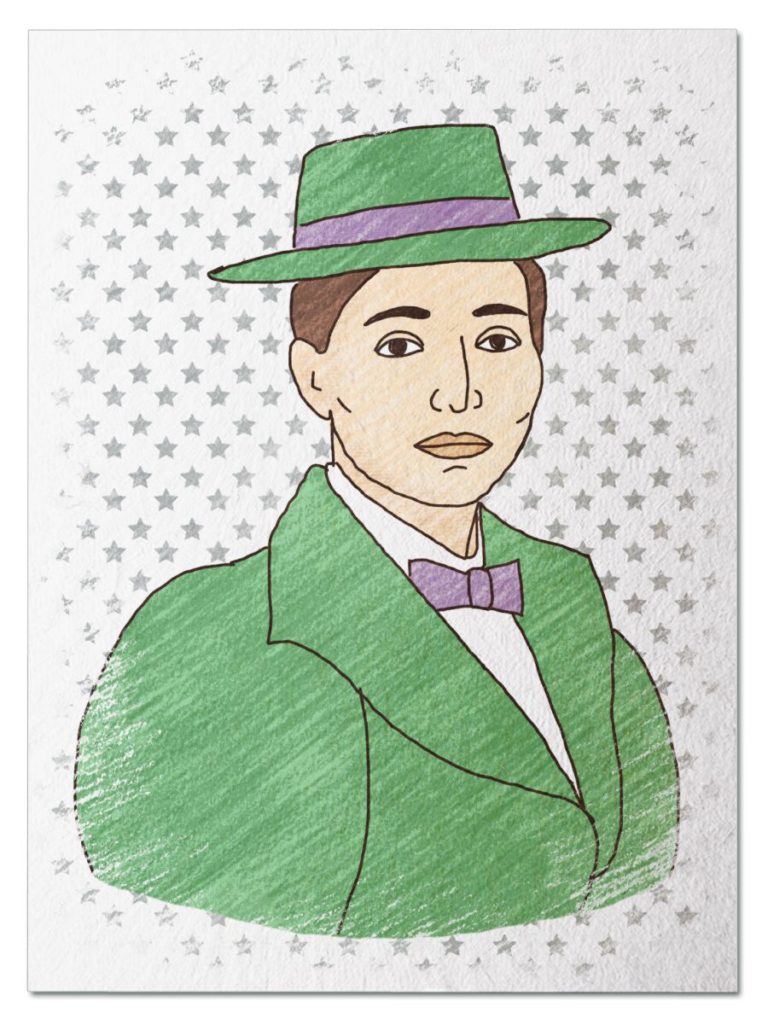
Audacious Adventurer
Growing up in the cramped tenements in the West End of Boston made her yearn for the freedom and independence of the open road. At 23 years old, she waved goodbye to her husband and three children and embarked on a grand adventure around the world on a bicycle. Along the way, she became a pioneer in the movement for women’s equality. Pedal back in time to 1894 and ride with Annie Cohen “Londonderry” Kopchovsky …
Her Ruby Shoe Moment
The Power of the Wand
Her Yellow Brick Road
Brains, Heart & Courage
Glinda’s Gallery
Just the Facts
Her Ruby Shoe Moment
Annie “Londonderry” Kopchovsky cycled out of Chicago about 10:00 AM on October 14, 1894. Her goal was to bike around the world in 15 months and pay for all her expenses along the way. Annie was quite a spectacle — she wore pants (rather than a long skirt), rode a men’s bike, and was escorted out of town by some of Chicago’s women cyclists.
As she rode along, Annie experienced deja vu — she was retracing her steps back to New York City. Three weeks earlier, Annie had begun her journey in Boston and headed west. When she reached Chicago, however, Annie realized that she couldn’t make it across the nation before winter. So she revised her plans and decided to travel to Europe instead.
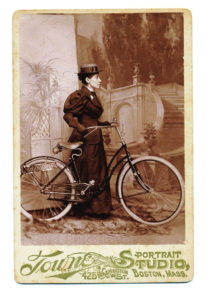
annielondonderry.com
Once Annie reached New York City, she boarded a steamer for France. She arrived in Le Havre on December 3 and hopped a train to Paris, where she stayed for a few weeks before heading south to Marseilles. While there, Annie perfected her methods of generating publicity and making money— she attended bike exhibits, secured sponsors, gave lectures and cycling demonstrations, sold autographed photos, and provided interviews to the press. She was charismatic and the public was fascinated with her (even though they didn’t understand English).
When Annie left Paris, she was a traveling billboard — she was covered from head to toe with ribbons that advertised everything from medicine to dry goods. In addition, signs were attached to every inch of her bike. Local newspapers reported her progress and she received an enthusiastic welcome in every town. Annie felt like a celebrity as she rode into Marseilles with a large group of local cyclists.
On January 20, Annie boarded a steamship for the next part of her journey. While aboard the ship, Annie rode her bike on deck and charmed the other passengers with tall-tales about her “adventures.” Her stories grew more unbelievable as time went by. She arrived in Japan only 7 weeks later — clearly there wasn’t much cycling involved! On March 9, 1895, Annie left Japan to cross the Pacific. She was headed home.
Annie reached San Francisco on March 23, nine months after leaving America. And she didn’t receive the welcome she hoped — journalists were critical of the commercial nature of her trip. Some cycling enthusiasts called her a fraud, since she cycled very little during her journey around the world. Annie continued to be controversial for the remainder of her journey.
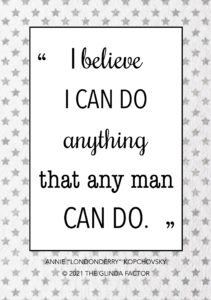 While in San Francisco, Annie planned her route to Chicago. She also answered mail, organized her photographs, and gave lectures to women on the benefits of physical fitness and the dangers of wearing a corset. A few weeks later, she set off on her bicycle again.
While in San Francisco, Annie planned her route to Chicago. She also answered mail, organized her photographs, and gave lectures to women on the benefits of physical fitness and the dangers of wearing a corset. A few weeks later, she set off on her bicycle again.
Annie headed south to Los Angeles and followed the Southern Pacific Railroad tracks across the desert to Phoenix and on to El Paso — although she probably rode the train whenever it suited her. Then, she headed north along the Santa Fe Railroad tracks through New Mexico to Denver. It was a rough ride in terrible weather. Annie arrived in Denver on August 12 and stayed for a few days to recover from pneumonia.
Annie was on the homestretch. She rode out of Denver, then traveled by train through part of Nebraska because of muddy roads. Then she biked through most of Iowa and Illinois, crashing into a group of pigs along the way. Annie finally rode into Chicago on September 12. She made it around the world with 14 days to spare!
The Power of the Wand
Annie “Londonderry” Kopchovsky used the bicycle to break free from Victorian ideals that constrained women. Annie was a pioneer in the struggle for women’s equality and a symbol of the New Woman. America experienced a bicycle craze in the 1890s, and women embraced the bicycle as a way to experience freedom, gain independence, get physical exercise, and wear more comfortable clothing. Generations of women have benefitted from women like Annie who championed the bicycle as part of the women’s movement. Today, there are numerous cycling groups for women and girls across America.
Her Yellow Brick Road
Annie was enamored with grand, bold adventures. She had read about them many times in the newspapers for which she worked. Just a few years earlier, Nellie Bly traveled around the world in a race against the fictional character, Phineas Fogg. Annie wanted a better life for herself, so she came up with her own radical idea of a trip around the world …. on a bicycle.
In February, 1894, Annie announced that she would make the journey to settle a bet between two wealthy Boston merchants. The bet required Annie to: (1) circle the earth by bicycle in 15 months, (2) leave with only the clothes on her back, and (3) earn enough money to pay her own way and return with $5,000. If she succeeded, Annie would get $10,000 (an astronomical sum at the time). Or so she said. It’s almost certain that Annie concocted the bet as a publicity stunt. And it worked.
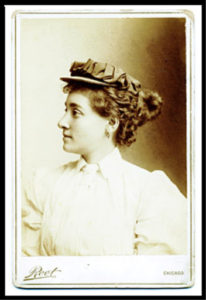
annielondonderry.com
Annie had three months to plan her trip. And the first thing she had to do was learn how to ride a bike! She had no experience on a bicycle and needed a few lessons. Back then, bikes were big and heavy. And she was petite — 5’ 3” tall and about 100 pounds. So she had some work to do.
Annie knew that sponsorships would help finance her trip. So she used her advertising sales skills and approached two local companies. Pope Manufacturing provided her with a 42-pound Columbia “safety” frame bike. The owner, Colonel Albert Pope, hoped that she would ride the bike during her entire journey since it was great advertising for his business.
Her second sponsor was the Londonderry Lithia Spring Water Company of New Hampshire, which paid her $100 to attach a sign to her bike and use the name “Annie Londonderry” throughout her trip. Besides advertising, the new name allowed her to travel incognito — it might have been harder to navigate certain parts of the world with her real name (which called attention to her Jewish heritage).
On Monday June 25, 1894, Annie stood before a crowd of 500 people at the Massachusetts State House and announced that she was going to travel around the world on a bicycle. Then, she climbed onto her bicycle, waved to her husband and three kids, and rode off down Beacon Street. But it was all for show. She didn’t actually leave until two days later.
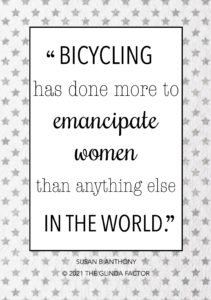 Annie biked down the coast to New York City, then headed west and eventually followed the Erie Canal. She made her way along Lake Erie, then through Indiana to Chicago. It took Annie over 3 months to bike 1,300 miles. She was completely exhausted and 20 pounds lighter when she arrived. Annie was discouraged, but refused to give up. So she came up with a new plan.
Annie biked down the coast to New York City, then headed west and eventually followed the Erie Canal. She made her way along Lake Erie, then through Indiana to Chicago. It took Annie over 3 months to bike 1,300 miles. She was completely exhausted and 20 pounds lighter when she arrived. Annie was discouraged, but refused to give up. So she came up with a new plan.
Annie realized that she needed a lighter bike. Her Columbia was big, heavy, and hard to control. So she approached the Sterling Cycle Company about a sponsorship. And it worked. They gave her a Roadster — a gold and ivory men’s diamond frame bike that weighed half as much as her Columbia.
Annie also decided that she needed a new riding outfit. She left Boston in a traditional Victorian outfit — a long skirt, corset, high collar jacket, gloves and hat. However, she soon found that the outfit was heavy, hot and inconvenient. So she ditched the skirt and corset, which was revolutionary at the time. Annie had a practical light blue suit made by a tailor, which consisted of bloomers and a jacket. After that, she shocked people everywhere she went. And she loved it.
Brains, Heart & Courage
Annie Cohen was born in Latvia and immigrated to America with her parents when she was 4 years old. She grew up in the West End of Boston, which was a diverse community that had a small Jewish community. Her parents both died when she was a teenager, leaving Annie and her older brother, Bennet, to care for their two younger siblings.
Annie met another Eastern European in neighborhood — Max Kopchovsky, who was a devout Orthodox Jew. They married when Annie was 18 years old and had three children in quick succession. Annie and her family shared their tenement apartment with her brother, Bennet, and his family (with 2 kids). It was a tight fit!
To make ends meet, both Annie and Max had to work. Max was a peddler of second hand clothes and other household items. Annie sold advertising space for several daily Boston newspapers. And she was good at it.
Glinda’s Gallery
Just the Facts
- Annie was born in Latvia in 1870 or 1871. She had 4 siblings (2 were born in America after they immigrated). Annie’s father died on January 17, 1887, and her mother died two months later.
- Annie married Simon (Max) Kopchovsky in 1888 and they had 4 children (one was born after her trip).
- Annie’s family shared a tenement apartment with her brother and his family.
- Max was a peddler of used clothes and Annie sold advertising for newspapers.
- After Annie returned from her trip around the world, the family moved to New York City while she pursued a journalism career.
- Annie wrote about her trip in the New York World on October 20, 1895, titled “the Most Extraordinary Journey Ever Undertaken by a Woman.” Her byline was Nellie Bly Jr.
- In 1897, Annie moved to California for about a year to work as a saleswoman. When she returned, she and Max owned a small clothing company in the Bronx.
- Annie died in of a stroke on November 11, 1947.
Want to Know More?
Gilles, Roger. Women on the Move: The Forgotten Era of Women’s Bicycle Racing. Lincoln: University of Nebraska Press, 2018.
Macy, Sue. Wheels of Change: How Women Rode the Bicycle to Freedom. Washington DC: National Geographic, 2011.
Weber, Bruce. Overlooked o More: Annie Londonderry, Who Traveled the World by Bicycle. The New York Times, November 6, 2019.
Zheutlin, Peter. Around the World on Two Wheels: Annie Londonderry’s Extraordinary Ride. 2007.
SPIN. A bicycle-themed performance by Evalyn Parry that premiered in 2011. It included a song about Londonderry (“The Ballad of Annie Londonderry”).
The New Woman – Annie “Londonderry” Kopchovsky. A documentary film by Gillian Klempner Willman of Spokeswoman Productions that premiered 2013. It won the award for Best Documentary at the DC Independent Film Festival.
